Lambert here: I love historical studies like this. Spoiler: “In the cities where political freedom was most limited – where the legal prerogatives of authoritarian rulers were greatest – competition and openness in the media delivered their biggest effects.” Makes you wonder whether that applies to the United States, or not, and what the effect of giant monopolies like Facebook might be. It’s also fascinating to see the effects of Luther’s “intervention” in 1517 shown in the charts; one person can make a difference, though of course the time must be right.
Jeremiah Dittmar, Professor of Economics, London School of Economics, and Skipper Seabold, Ph.D candidate in economics and econometrics, American University; Data Scientist, Civis Analytics. Originally published by VoxEU.
The use of social media and related technologies in the Arab Spring, Occupy Wall Street and the so-called ‘colour revolutions’ raise a number of questions. How much does the diffusion of radical ideas depend on technology itself? What role do openness and competition in media markets play? And how do the implications of new technologies and of competition depend on the initial institutional conditions?
Evidence from European history suggests that competition and openness in the media are crucial – and may have their biggest effects where political freedom is most limited.
The Protestant Reformation
The Protestant Reformation is a canonical example of the way that innovative media technologies may drive profound social change.
The technology at the heart of the Reformation was the printing press. The Reformation was the first mass movement to use the new technology and the first successful challenge to the quasi-monopoly of the Catholic Church.
In 1517, Martin Luther circulated his famous theses calling for reform within the Catholic Church. Almost immediately, the ideas of the Protestant Reformation began to spread in the media across cities in German-speaking Europe.
As Protestant ideas spread in the media, citizens’ movements emerged calling for reforms in church doctrine and an end to various forms of corruption. These urban movements were popular and largely middle class. They developed without the support of local princes and challenged the authority of city councils and urban elites, with civil disobedience, preaching, marches, and street theatre (Cameron 1991).
Where the reformers won power at the municipal level, they cemented their victories in new legal institutions. In Steven Ozment’s (1975) words, “The revolutionary program came to rest in an established religion; the pamphlet became a church ordinance… the new Protestant institutions persisted.”
It commonly suggested that without printing there would have been no Reformation. ‘No printing, no Reformation’ in Bernd Moeller’s famous aphorism (1979). But literacy rates were low even in cities – perhaps 30% – leading some scholars to argue that the conventional case for the role of new media should be qualified (Scribner 1994).
The Research Challenge
No research has systematically documented the diffusion of Protestant ideas in the media during the Reformation in quantitative terms. This is because the data on the media are large and complicated. There are thousands of publications – in historical German – by unknown authors. While about a third of publications from the 1500s were on religious topics, no existing data systematically classify the content or religious persuasion of this media.
Moreover, to study how technology and competition shaped diffusion, we need evidence on firms and media markets – which previously has not been constructed.
Documenting the diffusion of ideas in the media – high dimensional data
In new research, we construct a novel measure of religious content in the media (Dittmar and Seabold 2015). We examine all known books and pamphlets produced in German-speaking Europe 1450-1600 – over 108,000 individual publications produced in over 100 cities.
We construct a measure of religious content by using statistical methods for high dimensional data. A large literature uses statistical models to study sentiment and ideology in the language of twitter ‘tweets’ and of contemporary news media (e.g., Gentzkow and Shapiro 2010, Taddy 2013). We take these models for text data to the historical evidence from the Reformation and obtain an index of content.
Figure 1 presents the big picture from the aggregate time series. Following Martin Luther’s first intervention in 1517, we see a discontinuous shift in the religious content of the media, away from Catholic (0) towards Protestant (1). This shift is observed in both German and Latin religious media. We also observe a sharp increase in the number of religious publications in the vernacular – as captured by the scale of the markers in the graph.
Figure 1. Index of religious content in the media
Determinants of Diffusion
There are two big arguments in the historical literature. The first is that printing was absolutely critical to the diffusion of the Reformation. The second is that cities with constitutionally protected political freedoms played a key role in the movement’s development. The institutional distinction here is between the two principal types of cities formally recognised by the constitution of the Holy Roman Empire. In ‘free cities’, city councils had extensive policy autonomy. In the cities that were not ‘free’, citizens and municipal authorities fell under the legal jurisdiction of the local feudal lord.
The existing literature suggests that political freedom and the press were together behind the Reformation. Our evidence suggests a different and more nuanced picture, in which the economics of the media interacted with prior political institutions.
We find that cities with more competitive markets saw a much greater diffusion of the Reformation in the media. Moreover, this competition effect is even stronger in the cities that fell under the rule of local lords – where otherwise existing institutions placed the greatest barriers before the diffusion of radical ideas and movements.
Evidence on Competition and Radical Ideas
Historians have suggested that competition mattered. Andrew Pettegree (2000) observes that, “Where a market was controlled, the free flow of innovative theological speculation was greatly inhibited.”
We test this argument by constructing data on every firm operating in central Europe. We construct the data by examining the inscriptions that record the printer producing each individual book and pamphlet in our data, and cross-check these output based measures against records from biographical dictionaries of printers.
We then study how city-level market structure on the eve of the Reformation explains subsequent diffusion. We find that cities with more firms saw more Protestant media – even controlling for the overall size and composition of their media output prior to Reformation. We study over 190 cities and towns. Of these, 55 had printing before 1517 and the median city with printing on the eve of the Reformation had two firms active.
We find an additional firm just before the Reformation was associated with about a 20% increase in Protestant content. Moreover, Protestant content really increases when we compare cities with two or three firms to cities with no printing or simply a local monopoly.
Figure 2 illustrates this point by documenting the non-linear relationship between Protestant media and the initial number of firms (here we examine residual Protestant media, taking out variation explained by city size, prior religious output, the language composition of pre-Reformation output, and measures of local institutions).
Figure 2. Protestant ideas in the media and pre-Reformation competitors
Did Variations in Competition Cause Differences in Diffusion?
The obvious question is whether cities with more competitive media markets had other characteristics that made them receptive to reformist ideas. Maybe these cities were always more open to innovation? Or maybe these cities were experiencing new forms of cultural and economic dynamism just before the Reformation – inducing firms to enter and simultaneously predisposing them towards the coming religious innovations?
To isolate variations in market structure that are plausibly free of these forms of reverse causation we do two things. First, we study variations in competition that were induced by the chance timing of the deaths of master printers – which were independent of the more slow moving characteristics that may have made some cities more receptive to religious innovation than others.
Second, we study variations in competition that reflect longer run differences in city market structure and do not embody endogenous entry on the eve of the Reformation. Our results examining these two plausibly random sources of variation in market structure both support the view that competition was a key predictor of diffusion.
Institutional Change
The Protestant Reformation led to formal institutional change. These changes occurred first at the city level. Where reformers won power, city councils created new legal institutions, beginning in the 1520s. The new laws reformed church governance and social welfare provision and established the most ambitious early experiments in mass public education in European history.
Previous research in economics has not examined these formal institutional changes. We code up which cities got the legal ordinances of the Reformation and then study the relationship between competition, exposure to content, and legal change.
Figure 3 shows that most of the legal innovation occurred before the mid-1500s. In the mid-1500s, first military conflict, and then the new institutional equilibrium settled in law by the Peace of Augsburg (1555), arrested the diffusion of Protestantism.
Figure 4 maps the geography of municipal legal reform. Figure 5 shows that cities that did and did not change legal institutions had similar religious media before the Reformation and that there were no clear trends before 1517.
Figure 3. The laws of the Reformation
Figure 4. Legal Reformation across Cities 1518-1554
Figure 5. Religious content for cities that do and do not pass Reformation laws
Determinants of Institutional Change
We find that variations in initial competition in media markets strongly predict legal change in cities that were under the jurisdiction of authoritarian feudal lords. In contrast, in the free cities, the relationship between prior competition and legal change is relatively weak. This evidence strongly suggests that competition in the media mattered most where citizens and policymakers otherwise faced the largest barriers to mobilisation and social change.
It is important to underline here that the media were used to galvanise citizens’ movements, which faced free rider problems and were challenging religious and secular elites. The constituency for reform came from citizens who were excluded from political power by oligarchic elites, typically lesser merchants and guild members (Ozment 1975, Schilling 1983).
Cameron (1991) observes that, “As a rule neither the city patricians nor the local princes showed any sympathy for the Reformation in the crucial period in the late 1520s and early 1530s; they identified themselves with the old Church hierarchy and accordingly shared its unpopularity. Popular agitation on a broad social base led to the formation of a ‘burgher committee’.”
This model notably characterised the Reformation in its birth place – “It is undeniable that the Wittenberg movement was borne on a wave of popular enthusiasm. It outran the city magistrates’ ability to control it, and finally forced them to act even against the will of the Elector [the territorial ruler of Wittenberg], who had prohibited any innovations in church matters” (Scribner 1979; p. 53).
Why Competition Mattered
While producers were motivated by belief, printing was a competitive business in which religion was a dimension for product differentiation. In cities with just a local monopolist that printer was de facto or de jure the ‘city printer’. Faced by an adversarial monopolist, city councils might encourage a new entrant. In cities with multiple printers, one printer was typically the official city printer (ratsbuchdrucker) and the rest were not.
The fact that known city printers were not early advocates of the Reformation is consistent with the view that they did not want to endanger official work orders or antagonise city governments, while outsiders may not have been so constrained.
The Big Picture for Economics
An influential body of scholarship traces differences in contemporary economic performance and behaviour to historically determined institutions or beliefs (Acemoglu et al 2001, 2011; Voigtlander and Voth 2012; Guiso et al 2003). This literature raises the question – What explains the dynamics of fundamental institutional change?
The Reformation interests us as arguably one of the most important changes in social institutions of the last several centuries.
We specifically study environments in which the media were used to solve free rider problems and mobilise citizens’ movements that aimed to transform social institutions.
Our key findings suggest that the diffusion of the Reformation was not driven by information technology acting alone. We find that competition in media markets mattered. In the cities where political freedom was most limited – where the legal prerogatives of authoritarian rulers were greatest – competition and openness in the media delivered their biggest effects.
References
Acemoglu, D, S Johnson, and J Robinson (2001) “The colonial origins of comparative development: An empirical investigation,” The American Economic Review, 91(5): 1369–1401.
Acemoglu, D, D Cantoni, S Johnson, and J Robinson (2011) “The consequences of radical reform: The French revolution,” The American Economic Review, 101: 3286–3307.
Dittmar, J and S Seabold (2015) “Media, markets and institutional change: The Protestant Reformation”.
Cameron, E (1991) The European Reformation, Clarendon Press.
Gentzkow, M and J M Shapiro (2010) “What drives media slant? Evidence from US daily newspapers”, Econometrica, 78(1): 35–71.
Guiso, L, P Sapienza and L Zingales (2003) “People’s opium? Religion and economic attitudes”, Journal of Monetary Economics, 50(1): 225-282.
Moeller, B (1979) “Stadt und Buch”, in W Mommsen (ed), Stadtburgertum und Adel in der Reformation, Stuttgart. Ernst Klett.
Ozment, S E (1975) The Reformation in the Cities: Appeal of Protestantism to Sixteenth Century Germany and Switzerland, volume 357, Yale University Press.
Pettegree, A (2000) The Reformation World, Routledge.
Schilling, H (1983) “The Reformation in the Hanseatic cities”, The Sixteenth Century Journal, 14(4): 443–456.
Scribner, R W (1979) “The Reformation as a social movement”, in W Mommsen (ed), Stadtburgertum und Adel in der Reformation, Stuttgart. Ernst Klett.
Scribner, R W (1994) For the sake of simple folk: Popular propaganda for the German Reformation, Oxford University Press.
Taddy, M (2013) “Measuring political sentiment on Twitter: Factor optimal design for multinomial inverse regression”.
Voigtlander, N and H-J Voth (2012) “Persecution perpetuated: The medieval origins of anti-semitic violence in Nazi Germany”, Quarterly Journal of Economics, 127(3): 1339-1392.
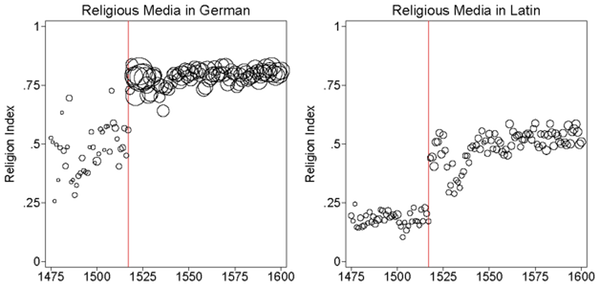
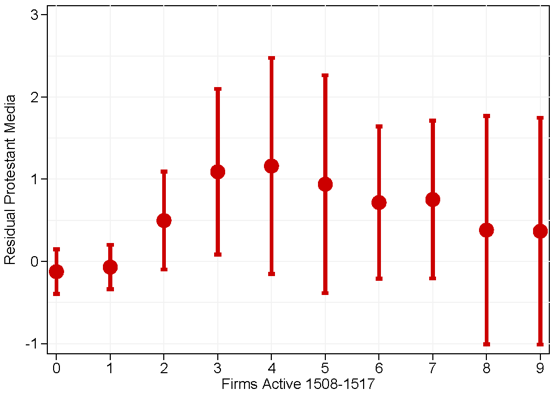
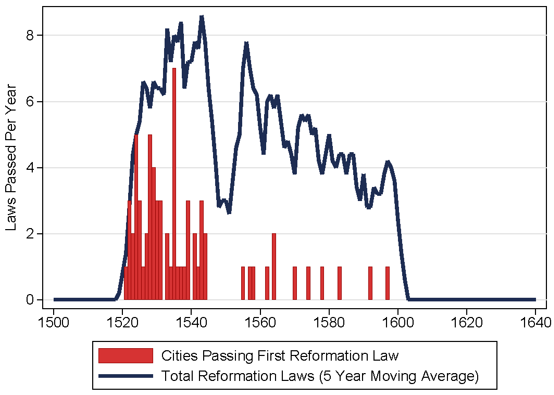
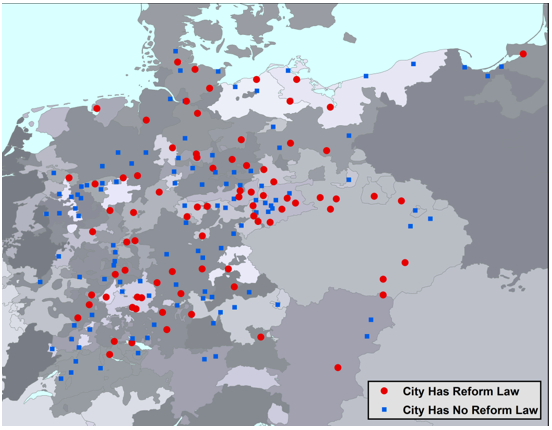
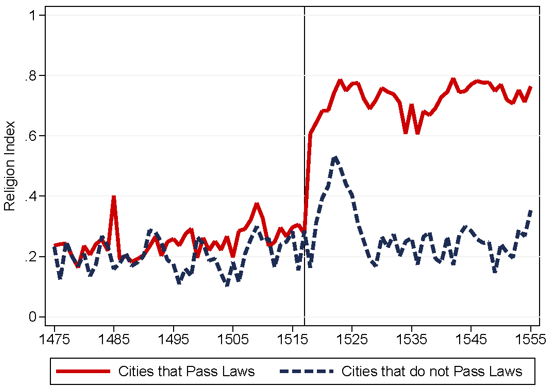


Terrific work–but it fails to connect information with action. If you did a media study of articles related to the notion of inequality before Occupy and Piketty and after them, the results would be just as impressive. Yet nothing has changed. Give the slow speed of information diffusion and institutions that were rarely if ever formally responsible to publics, the changes in Germany are absolutely stunning (or the lack of changes today bewildering). This work needs continuation and elaboration.
Cities were where the literate people were and also where universities were. No accident that Wittenberg was a college town. If people couldn’t read they had ready access to others who were literate and could read to them.
“The Protestant Reformation led to formal institutional change.”
“What explains the dynamics of fundamental institutional change?”
What if it wasn’t the Protestant Reformation that led to formal institutional change but rather the creation of cities themselves–separate from theological doctrine–that led to economic development.
Cities, to the extent they won political autonomy, were perhaps the first approximation of a new kind of political/economic environment featuring competition, individualism and different types of representative democracy. It also can be argued that by the twelfth century the city had become a powerful attraction for serfs, for merchants, and for artisans.
The creation of the city-state, the city and radical political decentralization, rather than the Protestant reformation, may have been a more decisive factor in explaining the origins of economic development and institutional change..
The argument seems to me to under-rate the extent to which more communication not only spreads information and social persuasion, but also limits and defines the effect of the information on society.
The assumption appears to be that there are these two pre-existing doctrines: Catholicism and Protestantism. Catholicism had long existed, Protestantism sprang from Martin Luther’s head. However, much of what came to characterize Protestantism had been minority viewpoints for some time. Luther, after all, tacked up his theses for debate within the Catholic Church.
In response to the diffusion of information, people began to form group identities based on various ideas for reform. As the Catholic Church began pursuing as heresies ideas that it had formerly ignored, Luther and other reformers attacked the Church’s response, and then rejected the Church. Group-defining media responded to the situation. The Catholics responded with the Council of Trent, which formally designated reform ideas as heresies.
I’m saying that the technological revolution of the printing press wasn’t just spreading innovative theological ideas — it was promoting a big social/political grouping, the tribalism of its time. I wish there had been some way in the study to look at not just “Catholic vs. Protestant” ideas, but at group bonding of us against them. We think of an explosion of information as mentally expansive, but it is simultaneously constrictive. We deal with it by constructing or adapting new ideological frameworks that are frequently less inclusive and tolerant than what went before. I find this restrictive role of more information interesting, and not usually very well dealt with.
How might relative restrictions on political freedom and media in Saudi Arabia, for example, play out to facilitate some type of Islamic Reformation?
Evidence from European history suggests that competition and openness in the media are crucial – and may have their biggest effects where political freedom is most limited. The Protestant Reformation is a canonical example of the way that innovative media technologies may drive profound social change.